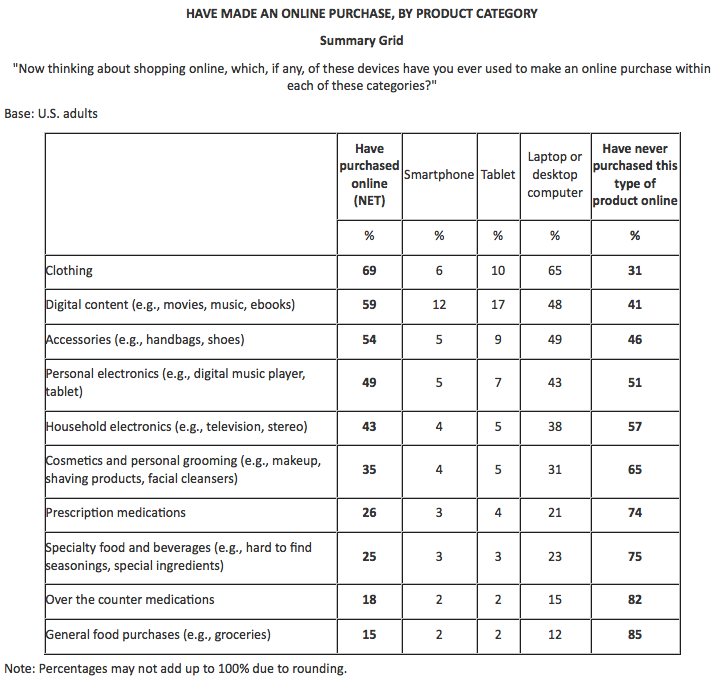What Consumers Buy Online, And What They Use To Do It

The near ubiquity of smartphones and tablets is affecting consumers’ shopping habits, as a new Harris Poll points out certain technology preferences consumers have in buying stuff online. Still, consumers have their preferences on what to buy in stores as well, and age differences also can determine what, where and how folks buy.
What consumers buy online and with their phones or tablets can say a lot about what strategies retailers should take in promoting goods and services. But a recent Harris Poll suggests they might as well promote everything.
Indeed, there’s little that consumers can’t buy online these days, and do it from anywhere. Among those consumers Harris polled, however, there were a few favorites of note that suggest certain buying and technology preferences.
Some 69 percent of 2,241 U.S. adults polled online between June 11 and 16, for example, said they had purchased clothing online, while 59 percent, noted digital content, 54 percent mentioned such accessories as handbags and shoes, and 49 percent had purchased personal electronics such as digital music players or tablets online, according to the survey results.
Most of these purchases occurred on traditional computer screens, but smartphones and tablets are making some clear inroads, Harris said. The poll found that, among smartphone owners, 20 percent had purchased digital content using such devices, while 9 percent had used a smartphone to purchase clothing or personal electronics, and 8 percent had bought accessories.
Moreover, 36 percent of tablet owners had used such a tablet to purchase digital content, while 22 percent had used one to purchase clothing and 19 percent bought accessories. In addition, 16 percent had used a tablet to purchase personal electronics, while roughly 12 percent used one to buy cosmetics, 12 percent bought personal grooming products, and 9 percent acquired household electronics.
Age differences
Not surprisingly, younger generations were more likely to have made purchases online in most of the product categories evaluated. However, prescription medications were by far the favorite among the older crowd. According to Harris, 40 percent of Matures (ages 68 and older) had acquired prescription drugs online versus 27 percent of Baby Boomers (ages 49 to 67), 26 percent of Gen Xers (ages 37 to 48) and 18 percent of Millennials (ages 18 to 36).
At 75 percent versus 63 percent respectively, women were more likely than men to have purchased clothing, including accessories (60 percent versus 47 percent) and cosmetics/grooming products (41 percent versus 28 percent) online. Meanwhile, men were more likely than were women to have purchased digital content (62 percent versus 56 percent respectively), personal electronics (55 percent versus 43 percent) and household electronics (49 percent versus 37 percent) online.
Many Americans may shop online, but a clear preference exists for shopping in person across most of the product categories tested, including 78 percent of respondents who cited general food purchases and 67 percent who preferred to go to the store for over-the-counter medications. Even personal electronics – the category showing the strongest online shopping preference – showed a preference for buying in person at 43 percent versus 22 percent who preferred buying such products online.
Shipping preferences
As for shipping, costs were a hot-button online shopping issue, with free shipping and free postage for sending returns or exchanges by heavy factors that would make consumers more likely to make such purchases online.
While most Americans show resistance to paying for shipping, not all shipping is created equal, as 22% of respondents said they would pay more for either overnight or same-day delivery, with 15 percent saying they’d pony up for overnight service and 14 percent for same-day delivery. Among those who would pay extra for same-day delivery, 60% percent would pay $10 or more and the average up-charge they could live with is $13.90.
Among those willing to pay for overnight shipping, 45% would pay $10 or more, and willing shoppers would pay up to $11on average, Harris said.

